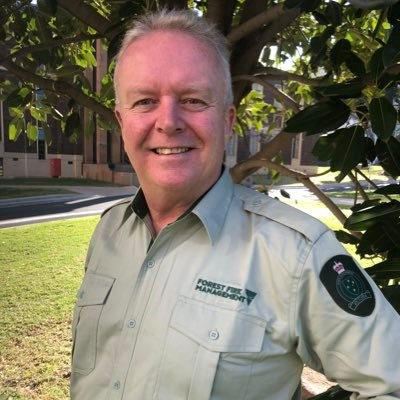 As the Chief Fire Officer for Forest Fire Management Victoria (FFMVic), my role is to keep the community and our environment safe from bushfire risk. More than ever, the impacts of climate change and its impact on the work we do is at the forefront of our thinking, planning and actions.
As the Chief Fire Officer for Forest Fire Management Victoria (FFMVic), my role is to keep the community and our environment safe from bushfire risk. More than ever, the impacts of climate change and its impact on the work we do is at the forefront of our thinking, planning and actions.
The latest Intergovernmental Panel on Climate Change (IPCC) report is a clear reminder that we have a fight on our hands.
Victoria is one of the most bushfire prone regions in the world, and while bushfires have always been present in Victoria – climate change is making bushfires worse.
We’ve seen a 170% increase in bushfire ignitions in the past 50 years. In that same period, we’ve seen a 20% decrease in spring rain.
There has been a 40% increase in very high fire danger days, and this is set to triple in some parts of Victoria by the end of the century according to research recently published in the International Journal of Wildland Fire.
Every year, we have more than 1000 bushfires in Victoria and 90% of those start in our forests, underlining the crucial role we have at Forest Fire Management Victoria in protecting communities, local economies and the environment.
The drier conditions mean we are living with more flammable forest undergrowth and drier gullies, which combine to create faster moving, more intense fires. Fire risk is increasing in more and different places than we’ve previously recorded.
We are seeing more unstable weather patterns which have become increasingly more extreme and damaging.
What this tells us is we need to be smarter and find new ways to manage our bushfire risk to protect communities and our environment.
Alongside my colleagues at FFMVic, communities and partner fire agencies the Country Fire Authority (CFA) and Fire Rescue Victoria (FRV), we are continuously innovating to meet these risks head on:
- There are fewer ‘ideal’ days for doing planned burns, so we’ve moved from autumn and spring burning to a year-round approach - we are able and ready to conduct burns 365 days a year when conditions allow
- Where planned burns aren’t possible, either due to the type of landscape or proximity to communities, we are increasing our use of mechanical fuel treatments – this means mulching, slashing and mowing vegetation so it’s not available to burn
- We’re doing more precision burning close to where people live to help protect homes, water catchments, power supplies, schools, hospitals and key transport routes
- We are building more Strategic Fuel Breaks – these are literal breaks in forested areas that help us to stop fires from continuing on a path to a community or critical infrastructure, and they double as access routes for our forest firefighters toget to any fires that do start
- We are increasing our capacity for effective and rapid first response – we know that fires are going to start, so we need to be able to access them and put them out quickly before they spread. Last bushfire season 95% of all fires were contained at the first attack (by 8am the next day) and 97% were kept to less than five hectares in area
- We are using science and modelling to best plan where and how our bushfire risk management activities should happen – we don’t just guess or do work to meet a meaningless target. We use weather and fire condition scenario models to show what could happen under those conditions if a fire were to start in a particular location, and figure out the best ways to stop or slow fires under those conditions
- Out in the back country forests we are doing large scale cool and mosaic (patch) burning to reduce the size, impact and intensity of fires that take hold giving us more ability to respond and contain them before they become mega-fires
- We also recognise and value the knowledge and experience of Victoria's First Peoples in living with fire. We actively support and enable Traditional Owner led cultural fire practices across the state, leading to healing and healthier Country.
While we’re expecting another relatively mild bushfire season in Victoria this year, we need to remember it’s everyone’s responsibility to manage bushfire risk – that includes being aware of campfire safety rules. A campfire that gets out of control can be disastrous.
To find out more about what my team at FFMVic and I are doing to help keep Victoria safe from bushfires, head to www.ffm.vic.gov.au/bushfire-management-facts.
Chris Hardman
Chief Fire Officer, Forest Fire Management Victoria
An abridged version of the letter has appeared in the Herald Sun and Weekly Times.
Language downloads
- Arabic (PDF, 216.8 KB)
- Arabic (DOCX, 32.7 KB)
- Filipino (PDF, 171.7 KB)
- Filipino (DOCX, 29.6 KB)
- Greek (PDF, 184.0 KB)
- Greek (DOCX, 32.9 KB)
- Hindi (PDF, 257.5 KB)
- Hindi (DOCX, 35.3 KB)
- Khmer (PDF, 155.8 KB)
- Khmer (DOCX, 33.4 KB)
- Simplified Chinese (PDF, 581.8 KB)
- Simplified Chinese (DOCX, 32.2 KB)
- Thai (PDF, 232.6 KB)
- Thai (DOCX, 33.7 KB)
- Traditional Chinese (PDF, 610.5 KB)
- Traditional Chinese (DOCX, 32.2 KB)
- Vietnamese (PDF, 289.9 KB)
- Vietnamese (DOCX, 32.5 KB)
Page last updated: 25/10/21